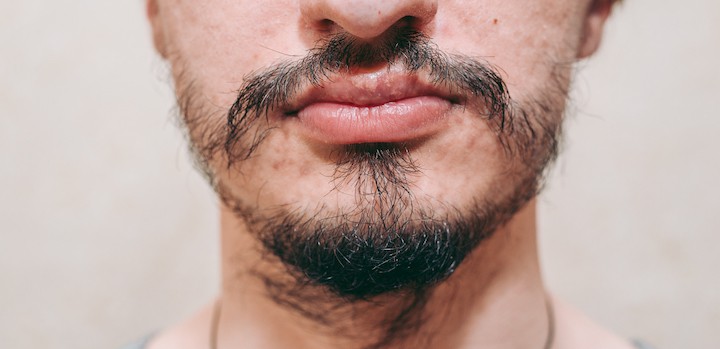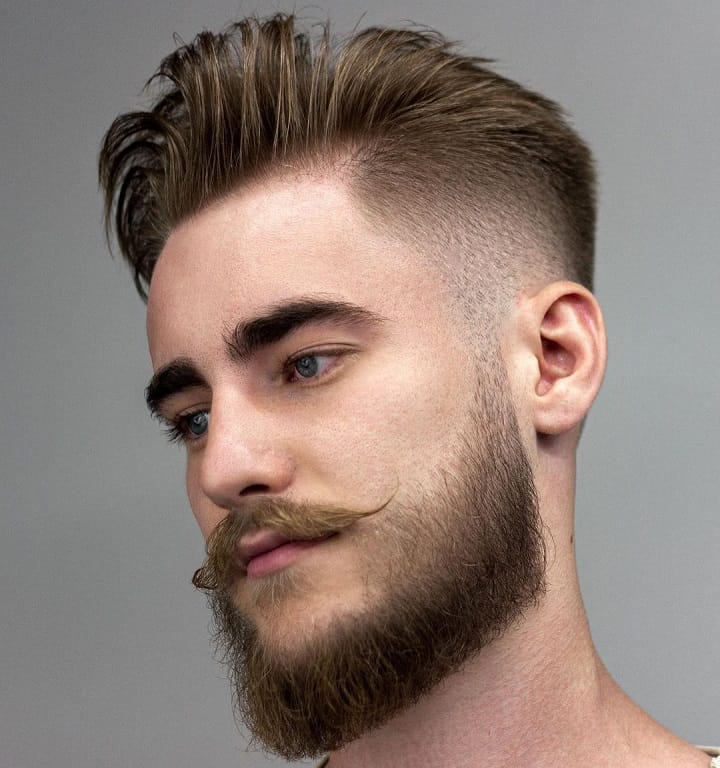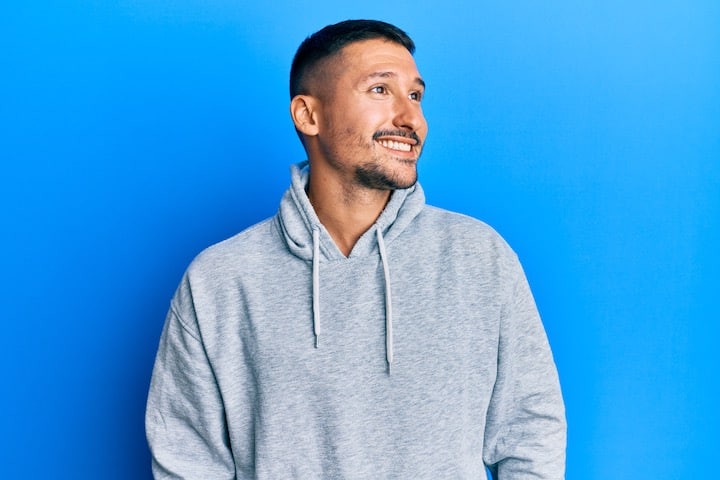Don’t you hate that feeling when you manage to grow a strong beard and a nice mustache, but the two simply don’t connect?
No matter what you use and how well you groom your facial hair, the two seem to exist like two separate entities.
It is a struggle that most men go through and to tell the truth it does not look good on some if they are unable to bring the two together.
Luckily, there is a solution and a way for your beard to connect to the mustache, and we have some of those fixes here in our article.
We gathered all the tips and tricks that you need to style your beard and mustache and bring them together.
No more doing a double grooming job.
Here are some ways to make a beard connect with a mustache or other parts of your facial hair.
Table Of Contents
Best Beard Styles to Wear
Van Dyke Beard
Photo @vadim_shifrin_barber
The Van Dyke beard style got its name from a 17th-century painter who made today’s iconic fashion statement. This beard style consists of a goatee and mustache that are not connected. Facial hair on the cheeks and the side of the lips would be shaved off, and the mustache can be either curled for an added flair.
Balbo Beard
Photo @mehdi_farahh
The Balbo beard consists of a different mustache and a beard that extends along the jaw. It is an inverted T beard with the mustache trimmed to create a floating effect, and the hair on the neck and cheeks is shaved clean. The beard can either be cut short or left long.
Anchor Beard
Photo @barbershopindonesia.id
The anchor beard is a stylistic look best suited for men with a sharp jawline. This beard style features a well-maintained and clean look that gives off an aura of confidence. To get this type of beard, the mustache and the beard are cut short and maintained at the same length to keep it from looking rugged or messy.
What Does It Mean the Beard Is Not Connected
Bare spots, gaps and patches on beards are beard enthusiasts’ worst nightmares. When a beard does not connect, it features bald areas typically around the sides of the mouth and the upper cheeks. These two areas are considered the most difficult to grow simply because facial hair does not usually grow here.
The follicles around the sides of the lips and the upper cheek are dormant and would not grow unless stimulated. The lack of facial hair on both areas often results in an unconnected and rather patchy mustache and beard.
Possible Reasons Why It Won’t Connect
Genetics
If you have always had the problem of growing facial hair since your teens, then the most likely reason would be genetics. If you notice that your father or uncles either have patchy beards or none at all, your genetics stop you from growing a full goatee. In cases like this, you might need to use products and eat food that promotes healthy beard growth.
Time
Aside from genetics, one of the reasons for a beard that won’t connect is simply time. Facial hair growth takes a while. If you are only a couple of months into your beard-growing journey, you will quickly notice the spots and gaps between the mustache, the beard, and the sideburns. Avoid obsessing over your beard and checking for progress all the time. Instead, make it a habit to use premium beard oil and natural beard shampoo to encourage hair growth.
Neglect
You may not know it, but your overall health also plays a significant role in the growth rate of your most-wanted beard. Stress, poor nutrition, and inadequate rest can affect the way your beard grows. Therefore, it is vital to ensure that you are fit and healthy so that your beard can grow naturally to its full potential.
Age
Facial growth in men typically starts when they enter adolescence. There are two hormones responsible for regulating body hair growth during this period. Dihydrotestosterone (DHT) and testosterone promote hair growth, allowing men to grow facial hair quickly.
As boys turn to teens and teens turn to men, these two hormones continuously facilitate facial hair growth. However, men can start growing a beard and a mustache as soon as they hit puberty, the more potent DHT hormone peaks in their 20s. During this time, facial hair starts to grow faster and thicker. Generally, the peak of facial hair growth starts when men reach their mid-20s to the mid-30s but drastically slows down from thereon.
How to Fix a Beard
Step 1 – Use beard rollers to encourage hair growth
Bald spots and bare areas can make your beard look weird and unattractive. One of the most common reasons for these gaps in the body’s the inability to grow facial hair in certain parts of the face.
The sides of the mouth and the upper cheek are considered the most difficult to grow hair. These are also the spots where the mustache connects to the beard, and the beard connects to the sideburns to create a glorious full beard.
Using beard shaping tools and techniques such as beard rollers can help promote hair growth on the face. Beard rollers feature micro-needles that puncture the epidermis to stimulate circulation and wake dormant hair follicles. The process is often called micro-needling and can help boost hair growth on bare spots and patches.
Step 2 – Apply beard care products
Beard enthusiasts spend time and effort not only in styling but also in caring for their beautiful mane. Using premium beard oil and natural beard shampoo can help nourish the skin and maintain the health of your facial hair. Applying beard oil and shampoo can make it feel softer and more manageable.
Also, as you massage your face with beard oil, you stimulate and exfoliate the skin to promote hair growth. Take note that choosing professional beard care products can ensure the quality and effectiveness of these items.
Step 3 – Practice a healthy lifestyle and diet
Your lifestyle and diet can affect the rate of hair growth. If you didn’t know, different types of food would promote healthy beard growth. These food types can help you fill the gaps and patches. At the same time, there are also food types considered to be effective natural DHT blockers that slow the rate of hair growth.
To promote hair regeneration, make sure that your diet has ample levels of zinc, sulfur, vitamin D, vitamin E, biotin, calories, and protein. Also, try to avoid or limit intake of these natural DHT blockers that can slow the process of facial hair growth, such as pumpkin seed oil, green tea, lycopene, and caffeine. Some of the world’s best beard vitamins can provide you with all the essential nutrients to promote growth.
Do’s and Don’ts With a Beard That Won’t Connect
Do’s
- Take your time and let your beard grow.
- Use a variety of beard shaping tools and techniques to promote growth.
- Establish a beard care routine.
- Take care of your health.
- Style your beard to hide bald spots and patches.
Don’ts
- Nitpick on the progress of your beard growth.
- Eat food items that are effective natural DHT blockers.
- Use cheap beard care products.
- Let your beard grow long without caring, maintaining, and washing it regularly.
FAQ
How can I fill gaps in my beard?
Fixing beard gaps can take some time. If you want a quick solution, you can use eyeliner to cover the bare spots in your beard. Draw slants to mimic hair strands and blend them in to cover up apparent patches on the cheeks, jaw effectively, and around the mouth.
If you’re still looking for options on how to make your beard thicker, know that you can also use hair-building fiber products. This type of product sticks to your pre-existing beard and mustache and creates the illusion that the beard is fuller and thicker.
The fibers look much like hair strands to keep the aesthetic uniform with the actual facial growth. These two techniques are quick solutions to annoying patches and gaps that make the beard look messy.
How do I make my beard sprout?
Microneedling is often considered the most effective technique to promote hair growth on a specific spot or area. The body regards the punctures created by the tiny needles as a wound. This circulates blood to the area that ultimately promotes growth by stimulating dormant hair follicles. Aside from that, you can also regularly exfoliate and moisturize your skin to encourage circulation.
How long does it take for the beard to connect?
Although the growth rate of facial hair differs from one spot to another, the process of growing a full beard can take roughly three to six months. If you have trouble growing facial hair on the sides of the mouth and the upper cheek to connect the mustache and the sideburn, it could take a couple more months to let the hair grow long enough to create a pseudo connection.
At what age does your beard stop filling in?
Facial hair growth in men is driven by dihydrotestosterone and testosterone hormones. While the peak of hair growth starts at 25, the rate drastically slows down as men reach 40 and above. Genetics also plays a crucial role in determining the decline of hair growth for an individual. Depending on genetics and lifestyle, the peak can occur as early as the early 20s and the fall as early as the 30s.
Conclusion
Having a beard that gloriously covers the chin, lips, and sideburns is like a crowning jewel for men. Although going clean or getting a full beard is a matter of style and preference, studies show that growing a full beard influences a man’s confidence.
It also provides them with a sense of masculinity, power, maturity, and an increased level of attractiveness. Unfortunately, some men can’t grow a full beard naturally, while some are too impatient to go through the process of thickening their stubbles.
In cases like these, men have several options for making their beards connect. They can either try to cover up the bald spot using make-up, make their beard grow thicker or longer, or accept the situation and style their beard in a way that works with their beard’s quirkiness. Either way, there is hope to make the uneven hair growth work the way you want it to.
Anthony Giannotti is a senior writer and editor for Beardoholic and a licensed barber for more than 13 years. He owns 3 barbershops and has his own hair care product line that is sold in barbershops worldwide. Known for his impeccable technique and skills, Anthony is an expert in hair and beard care and he knows the best products and tools to get rid of all beard problems and have an amazing beard.







